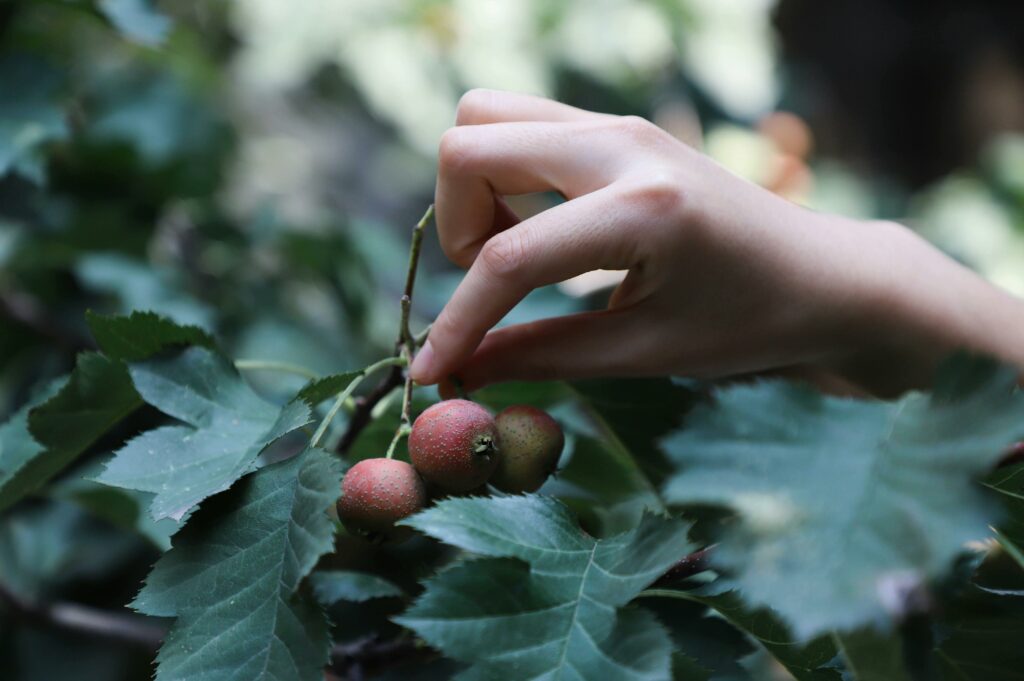eTHICAL fORAGING
Finding, identifying, and harvesting wild ingredients can be a joy. (It can also be plagued by mosquitos, poison ivy, and other inconveniences, but it’s worth it anyway.)
It is important to harvest responsibly and ethically to avoid damaging the overall ecosystem. Barbi Gardiner of the Outdoor Apothecary (https://www.outdoorapothecary.com/ethical-wildcrafting/), and Sam Sycamore, author of Introduction to Foraging, suggest some solid principles of ethical foraging that apply to jam and jelly ingredients just as well as they do to medicinal plants:
Stay safe
Be sure that you are foraging in areas that are safe – examples of no-go areas include habitats known to be frequented by mountain lions, venomous snakes, or mamma bears, and unstable ground near steep ravines. You also want a forage area free from environmental and natural contaminants. Do NOT harvest dandelions from your neighbor’s yard if they spray pesticides, or herbicides, or fertilizer. Lightly-traveled roadsides might be okay, but you want to be at least 100 ft from well-used roadways. Harvesting ground-level plants along animal trails may not be the best idea, either. Finally, always remember to test your sensitivity to plants before handling them.
ALWAYS be absolutely positive about what it is you’re harvesting
Do some research before you go foraging wild things, especially about look-alike plants, ESPECIALLY about *poisonous* look-alikes. Never ever gather something if you aren’t 100% sure of its identity. Buy a few good field guides, the kind with pictures, not drawings, and bring them with you. Even better, find someone local who knows their wild edibles and follow them around for a while.
Eat the Weeds
Focus on abundant plants (often called weeds by the uninformed) that proliferate in your area. Many of these are invasive, and you can feel absolutely virtuous while harvesting them. Dandelions, violets, garlic mustard, crabapples, barberries, and wild roses are all good examples.
Protect Vulnerable Plant Populations
There may be edible plants in your area that are rare, threatened, or endangered. No matter how yummy they might be, LEAVE THEM ALONE.
Avoid overharvesting, and never take more than you need
Never ever gather all of a fruit, herb, or flower from a particular area. Is the stand healthy, and large enough to harvest from without overly depleting it? If so, still only collect some of what’s available, leaving at least two-thirds of what you find. The exception to this rule is if you are harvesting invasive species. And remember your own ability to process what you’re gathering – don’t pick a gallon of berries if they’re going to rot before you can get around to dealing with them.
Be opportunistic
If you know a certain open space is slated for development, harvest away. Bring along some pots and a trowel or shovel to transplant some of the native plants that would otherwise be destroyed.
Do as little damage as possible
Leave your harvest area at least as happy as you found it. No trampling! Don’t leave discarded plant material lying around in a way that spoils the aesthetics of the area. Fill in any holes you’ve dug.
One last, very important consideration – do you need permission to harvest in a given area? If you’re foraging on someone’s private property, get their permission. If you’re wanting to forage on public lands, do your research first. According to the Bureau of Land Management, you may collect a reasonable amount flowers, berries, nuts, or other plant parts on public lands, as well as small amounts of mushrooms. You may NOT collect anything federally listed as threatened or endangered, and you should not harvest anything that is a candidate for being listed as such. You may NOT dig up plants on public lands. Rules are usually stricter for wilderness study areas, areas of critical environmental concern, national monuments or landmarks, or historic sites. Maps and information on specific restrictions are normally available from BLM offices (https://blm.gov/learn/Can-I-Keep-This). State and local governments also have their own rules; for instance, New York State prohibits foraging in state forests.
Have fun out there!

